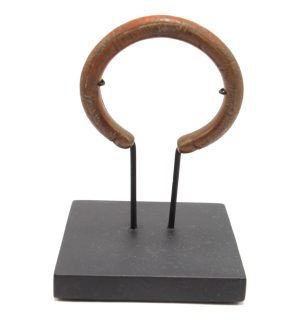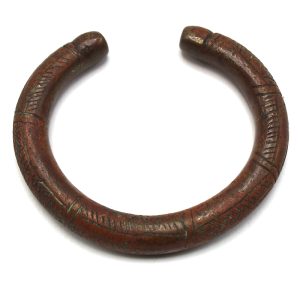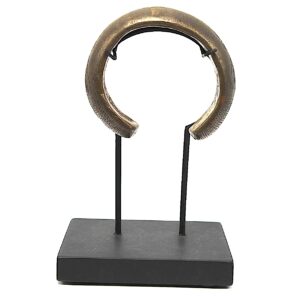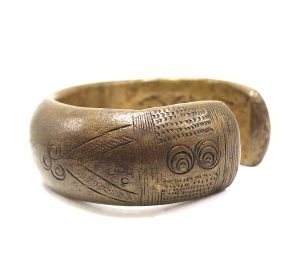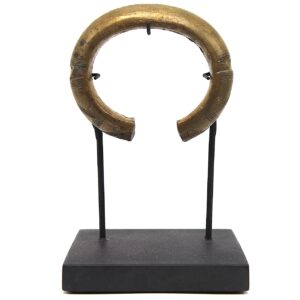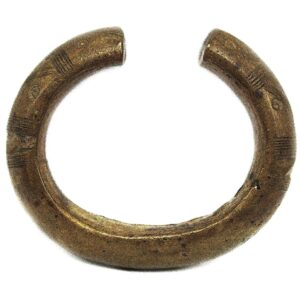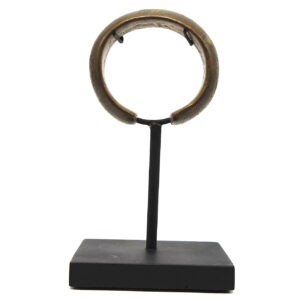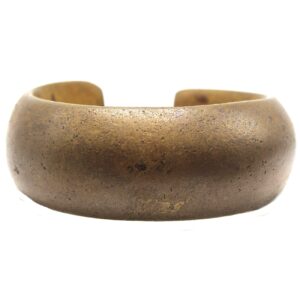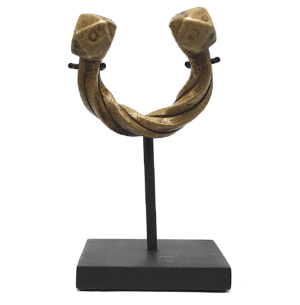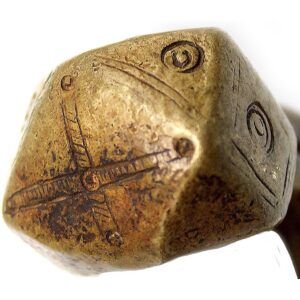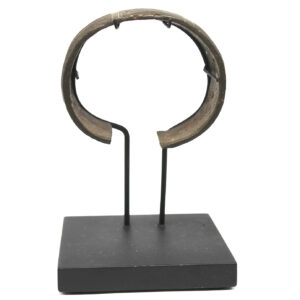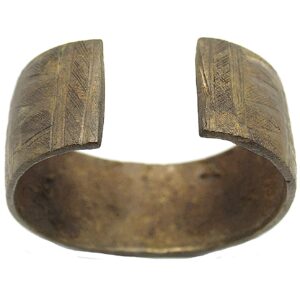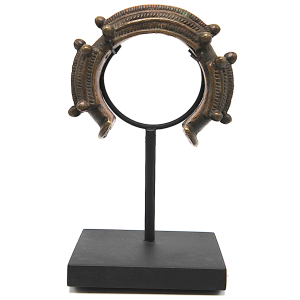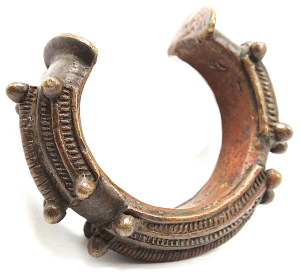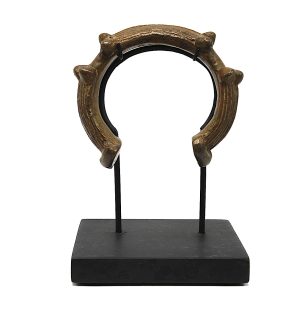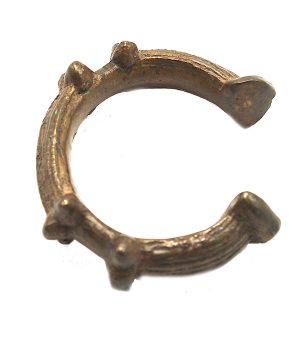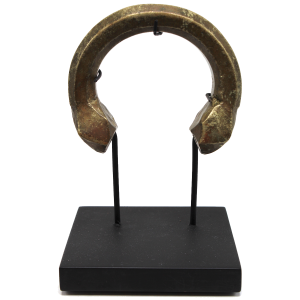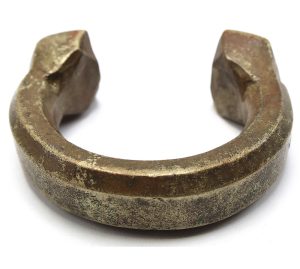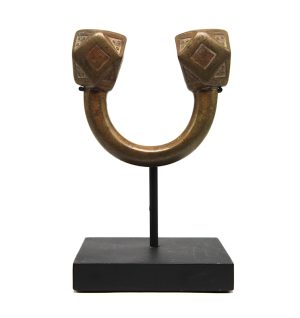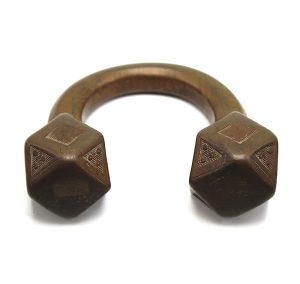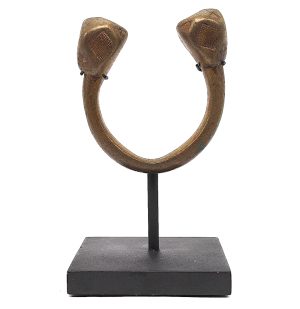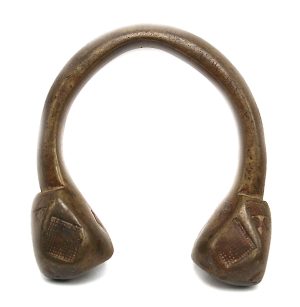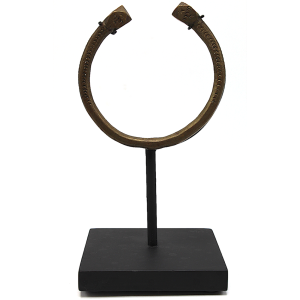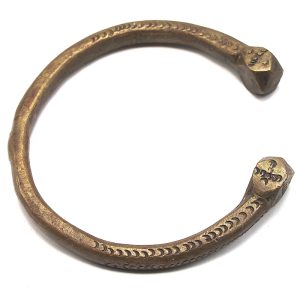Showing 1–12 of 13 results
-
Sale!


$110.00 Original price was: $110.00.$90.00Current price is: $90.00.
H: 2.75” W: 3.125” Thick: 0.375” Circum. 8.25” | FREE SHIPPING WITHIN CONTINENTAL U.S.
Antique Fulani manilla from Mali or Niger, thin C-shaped, rounded smooth surfaces inside divided into 6 sections with incised crosshatch and linear designs. Fine patina, excellent condition signs of use consistent with its age.
-
Sale!


$170.00 Original price was: $170.00.$145.00Current price is: $145.00.
H: 2.75” W: 3” Thick: 0.5” Circum: 8” | FREE SHIPPING WITHIN CONTINENTAL U.S.
Antique thick, rounded and smooth Fulani manilla etched with intricate geometric designs at the ends and apex.
-
Sale!


$185.00 Original price was: $185.00.$145.00Current price is: $145.00.
H: 2.75” W: 2.875” Thick: 0.5” Circum: 8.75” | FREE SHIPPING WITHIN CONTINENTAL U.S.
Antique thick metal manilla, smooth rounded outer surface with deeply etched and stamped traditional designs of triangles, horizontal bands, circles, facets and groves, flat ends. Excellent condition with fine patina.
-
Sale!


$195.00 Original price was: $195.00.$155.00Current price is: $155.00.
H: 2.625” W: 3” Thick: 0.25” Circum. 8.25” | FREE SHIPPING WITHIN CONTINENTAL U.S.
Found in Nigeria, this large C-shaped beautiful antique manilla has rounded smooth surface with fine etched linear design, circles, swirls, stipples, and V-shapes. Fine aged patina, comes with wood and metal stand.
-
Sale!


$295.00 Original price was: $295.00.$225.00Current price is: $225.00.
Ht: 3.125” W: 3.5” Thickness: 1”| FREE SHIPPING WITHIN CONTINENTAL U.S.
Antique finely-crafted, heavy and massive antique horseshoe-shaped currency bracelet, elaborately designed with intertwined twisted strands, 11 faceted ends incised with circle and diamond designs.
-
Sale!


$115.00 Original price was: $115.00.$90.00Current price is: $90.00.
H: 2.875” W: 3.25” Width: 1.5” | FREE SHIPPING WITHIN CONTINENTAL U.S.
This antique manilla is made by the Kota in the northeastern region of Gabon and Congo. A thin wide C-shaped bracelet with an elaborate five section design, each section has unique designs with long striations, grooved crosshatches, long triangles and angled designs. In very good condition with minor losses, pitting and scratches, its rough surface inside is consistent with its age and use and comes with a wood and metal stand.
-
Sale!


$295.00 Original price was: $295.00.$210.00Current price is: $210.00.
H: 3.125” W: 4” Thick: 1.125.5” Circum: 9.5” | FREE SHIPPING WITHIN CONTINENTAL U.S.
Heavy antique exquisite C-shaped Senufo manilla, divided into ornate sections, deeply carved, pairs of raised round metal pieces. Fine patina with wood and metal stand.
-
Sale!


$195.00 Original price was: $195.00.$155.00Current price is: $155.00.
H: 2.75” W: 3.625” Thick: 1” Circum. 9.375” | FREE SHIPPING IN CONTINENTAL u.s.
Antique 3-sections Senufo manilla with incising, raised bosses and flattened discs at ends. Very heavy, used to store wealth, trade for purchases, bridal dowries or ceremonies. Fine patina, wood and metal stand.
-
Sale!


$295.00 Original price was: $295.00.$225.00Current price is: $225.00.
H: 3.375” W: 3.25” Thick: 1.25” Circum: 5.75” | FREE SHIPPING IN CONTINENTAL u.s.
Large C-shaped Tuareg manilla made from sand moulds, has massive finials with 12 facets with detailed hand-etched and hammered designs including raised circles.
-
Sale!


$325.00 Original price was: $325.00.$295.00Current price is: $295.00.
Ht: 4″ W: 4.6525″ Thick: 1.5″ Circum: 10.5″ | FREE SHIPPING WITHIN CONTINENTAL U.S.
Antique horseshoe shaped Tuareg “King” manilla, magnificent metalwork, 10 faceted flat finial ends with traditional etched and hammered geometric designs, excellent condition, fine patina.
-
Sale!


$285.00 Original price was: $285.00.$225.00Current price is: $225.00.
Bracelet H: 3.875” W: 3.5” Thick: 1.125” | FREE SHIPPING WITHIN CONTINENTAL U.S.
Tuareg horseshoe shape manilla with bulbous rounded faceted ends, hand hammered fine details.
-
Sale!


$195.00 Original price was: $195.00.$125.00Current price is: $125.00.
H: 3.5” W: 3.625” Thick: 0.50” Circum. 10.125” | FREE SHIPPING WITHIN CONTINENTAL U.S.
Finely fashioned Tuareg slim circular-shaped manilla bracelet/anklet, hand incised striated decorations, and faceted rounded beads at the open hoof-shaped terminals ends.
End of content
End of content

